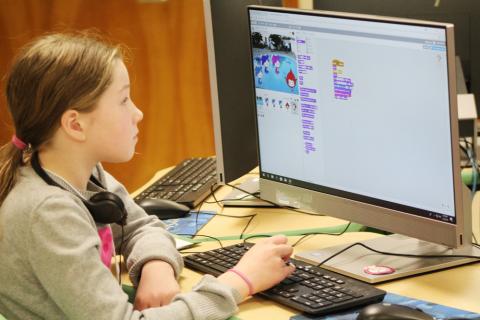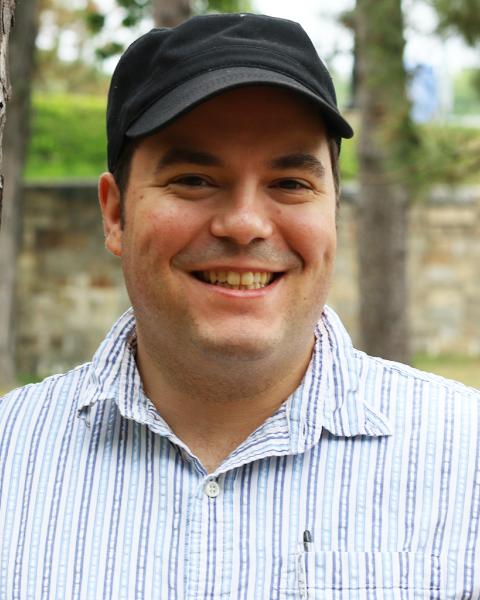Coded for Success

On an overcast afternoon in a computer lab in the Thorntons Ferry Elementary School in Merrimack, it’s raining tacos. Luckily for the school’s janitors, the torrent of tacos is taking place on a computer screen.
“You can program whatever you want,” says Brianna, a fourth grader and member of the CodeIT Girls after-school program. She’s pointing to a coding project she worked on during a previous session: animated tacos rain down from the sky while lightning flashes. “You can make it rain tacos. You can pick any backdrop you want, or you could pick flowers or pick a holiday setting and you can just program it and see what you can do.”
Brianna and the other members of CodeIT Girls meet each week and work on learning the basics of coding. Meera Kurup, a junior at Bishop Guertin High School and a local and national winner of the National Center for Women & Information Technology’s (NCWIT) Aspirations in Computing Award, leads the program.
“Joining NCWIT gave me the opportunity to begin my own program through their AspireIT initiative,” Kurup says. “I wanted to create a program that would be engaging for girls and show them how coding can be interesting and not as difficult as it seems. I thought looking at storytelling would be great."

Code and characters
A Thorntons Ferry alumna, Kurup partnered with Denise McLaughlin, the school’s education technology educator, and the UNH STEM Discovery Lab, to create CodeIT Girls. The program began in December 2017. Each week, Kurup prepares a lesson that guides the girls through Google CS, Alice, Scratch, and other programs that help students develop basic coding skills.
In Kurup’s program, storytelling is a vehicle for exploring coding. Using Scratch, the students select animated characters and a backdrop. Then, using a visual editor, they write code that puts the characters in action. They can jump up and down, zip around the screen, have a pool party, or even change their appearance.
“It’s extremely important for girls,” Kurup says. “They start noticing when they get into middle and high school that there’s a message that coding is difficult, or, ‘It’s not for me.’ I wanted to show them when they’re younger that there are opportunities for them, and technology isn’t as difficult as it seems.”
During each session, Kurup and staff and volunteers with the STEM Discovery Lab answer questions and help the girls puzzle out coding problems. On this afternoon, UNH Manchester computer science student Maggie O’Brien ’20 is helping Brianna figure out how to make a character glide across the screen.

“I want him to end up over here, and then turn,” Brianna says.
“Change that number to an 11, and let’s see what happens,” O’Brien says. A few clicks of the mouse later, the character on screen moves — but only by a few pixels.
“OK, try this: change the number to a big number of your choice,” O’Brien says. A few more clicks and it works — Brianna’s character glides across the screen and then turns and faces left.
“Yeah!” Brianna says. “Now I need to add music. I already know how to made sounds.”
“OK, I actually don’t know how to do that,” O’Brien says. “You can probably teach me.”
Role models and representation
This sort of collaboration is another of Kurup’s goals for CodeIT Girls. It’s vital for young girls to find role models in STEM fields, especially in tech. Knowing that women like Kurup and O’Brien are pursuing careers in computer science encourages the girls to keep learning and lets them know they have a place in the industry. According to a recent brief from Google and Gallup, girls are less likely than boys to see someone like them doing computer science, and interest in computer science among girls wanes as early as age 14.
“There’s way more than just programming,” O’Brien says. “Computer science is social media, it’s communicating, it’s being able to recognize a problem and solve it. And if you can’t solve it, what do you do?”
The UNH STEM Discovery Lab coordinates the Maine, New Hampshire and Vermont regional affiliate of the NCWIT Aspirations in Computing Award.
“These Aspire IT programs take the award a step further and allow the winners to develop important leadership skills,” says Emily Kerr, UNH STEM Discovery Lab coordinator. “It’s been fun to see Meera’s passion shine through with these girls, and I think Maggie and I have both gotten some ideas from her work. I hope CodeIT Girls inspires others to lead their own AspireIT programs.”
Stay connected
The UNH STEM Discovery Lab offers programs for youth and professional development opportunities for educators and volunteers. Subscribe to our newsletters for the latest updates.
Sign up for UNH STEM Discovery Lab professional development news
